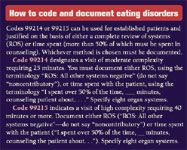The challenges of managing eating disorders in your office
Caring for a patient with an eating disorder can seem daunting. It doesn't have to be if you follow these practical guidelines.
DR. LAWRENCE is assistant clinical professor of pediatrics, University of North Carolina School of Medicine, Chapel Hill.
DR. PERRIN is assistant professor of pediatrics and director, pediatric eating disorders program, University of North Carolina School of Medicine.
DR. BENJAMIN is professor of pediatrics and chief, division of general pediatrics and adolescent medicine, University of North Carolina School of Medicine.
You are in your office on a Monday morning with a full clinic schedule for the day. A 17-year-old girl who has been in your care since her birth comes to see you for menstrual irregularity. You notice that she is quite slender, and her weight is 7 kg less than what was recorded when you last saw her six months ago. She seems not at all distressed by the weight loss and says she hopes to lose more. How do you proceed with her workup and evaluation? Your appointment time for this adolescent sick visit is only 30 minutes.

Eating disorders cause significant morbidity among adolescents and adults.1 Females are more likely than males to develop an eating disorder; the prevalence among young women is likely 3%,2 although many cases go undiagnosed.3 More important to the primary care pediatrician than the overall prevalence is the profound impact these illnesses have on a patient's health. Eating disorders have the highest mortality of any mental illness-estimated at nearly 6% per decade for adults.4,5
How are eating disorders classified?
Eating disorders can be divided into three major diagnostic categories: anorexia nervosa, bulimia nervosa, and eating disorders not otherwise specified (NOS).
Anorexia nervosa is defined by The Diagnostic and Statistical Manual of Mental Disorders, Fourth Edition (DSM IV) as a weight less than 85% of expected weight or failure to gain weight despite growth.6 It is classified as either the restricting type, in which the patient does not regularly engage in binge eating or purging, and the binge-eating/purging type, in which the patient regularly engages in these behaviors.6 A patient must meet all of the following criteria to be given a diagnosis of anorexia nervosa:6
Bulimia nervosa also falls into two categories. The purging type is characterized by the regular practice of self-induced vomiting or the misuse of laxatives, diuretics, or enemas. The nonpurging type occurs when the patient uses inappropriate compensatory behaviors for eating-such as fasting or excessive exercise-but does not engage in self-induced vomiting or inappropriate use of laxatives, diuretics, or enemas. To receive a diagnosis of bulimia nervosa, a patient must meet the following criteria:6
Having "the talk" with teen patients
June 17th 2022A visit with a pediatric clinician is an ideal time to ensure that a teenager knows the correct information, has the opportunity to make certain contraceptive choices, and instill the knowledge that the pediatric office is a safe place to come for help.
Artificial intelligence improves congenital heart defect detection on prenatal ultrasounds
January 31st 2025AI-assisted software improves clinicians' detection of congenital heart defects in prenatal ultrasounds, enhancing accuracy, confidence, and speed, according to a study presented at SMFM's Annual Pregnancy Meeting.